Clinical Audit in Nursing: Education, Effectiveness, Risk and Staffing
VerifiedAdded on 2023/04/11
|9
|2621
|324
Essay
AI Summary
This essay critically analyzes the impact of clinical audits within the nursing field, addressing key areas such as education and training, clinical effectiveness, risk management, and staffing and staff management. The paper begins with an introduction defining clinical audit and its importance in healthcare, followed by a background summary of its historical development. The core of the essay explores how clinical audits influence these four critical areas, providing specific examples and discussing the benefits and limitations associated with their implementation. The discussion includes the ways in which clinical audits improve education and training for healthcare professionals, enhance clinical effectiveness through standardized guidelines, contribute to improved risk management strategies, and influence staffing and staff management practices. The essay draws upon relevant literature to substantiate its arguments and concludes by highlighting the overall significance of clinical audits in enhancing the quality and safety of patient care, while acknowledging the constraints and challenges associated with their application.
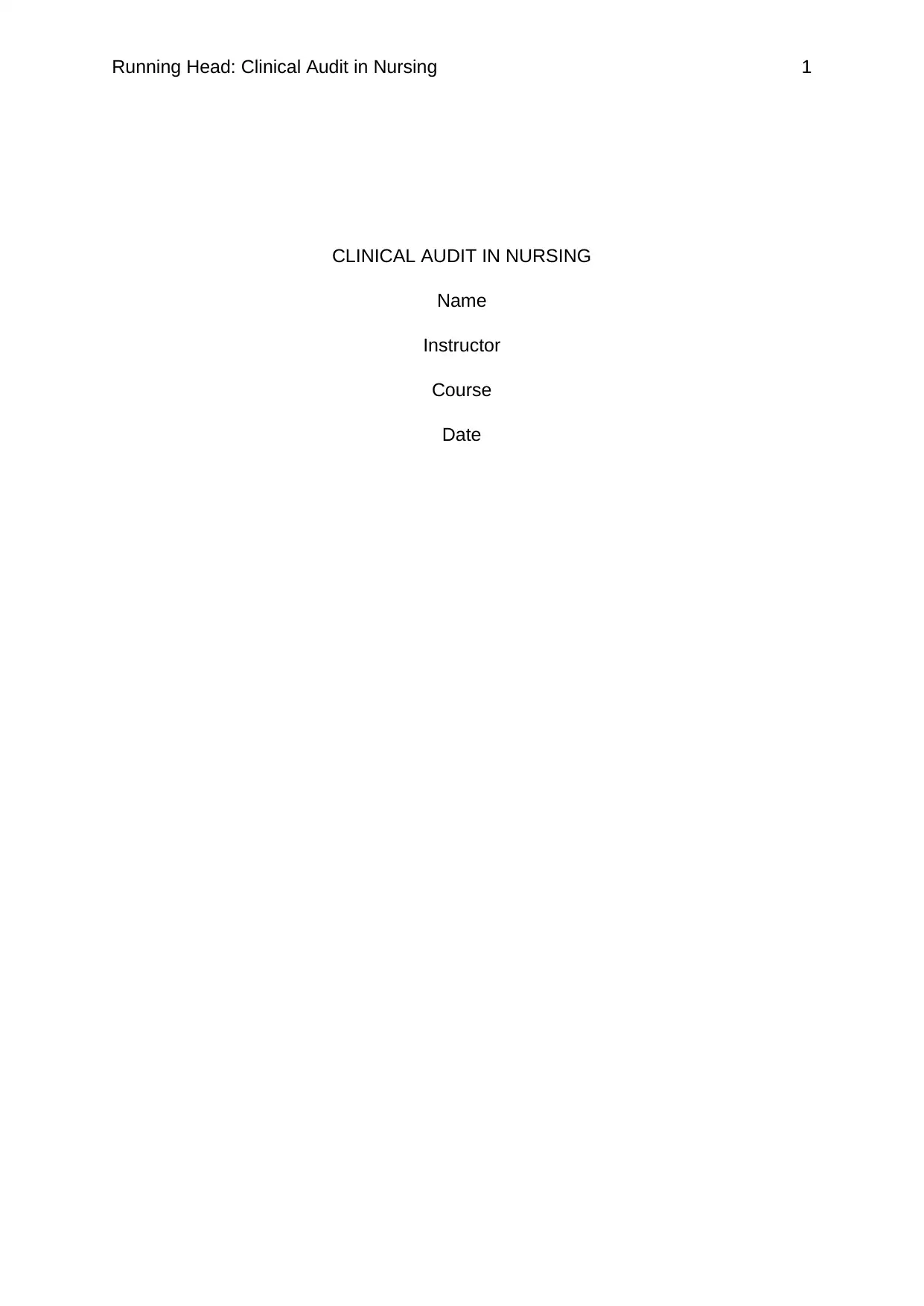
Running Head: Clinical Audit in Nursing 1
CLINICAL AUDIT IN NURSING
Name
Instructor
Course
Date
CLINICAL AUDIT IN NURSING
Name
Instructor
Course
Date
Paraphrase This Document
Need a fresh take? Get an instant paraphrase of this document with our AI Paraphraser
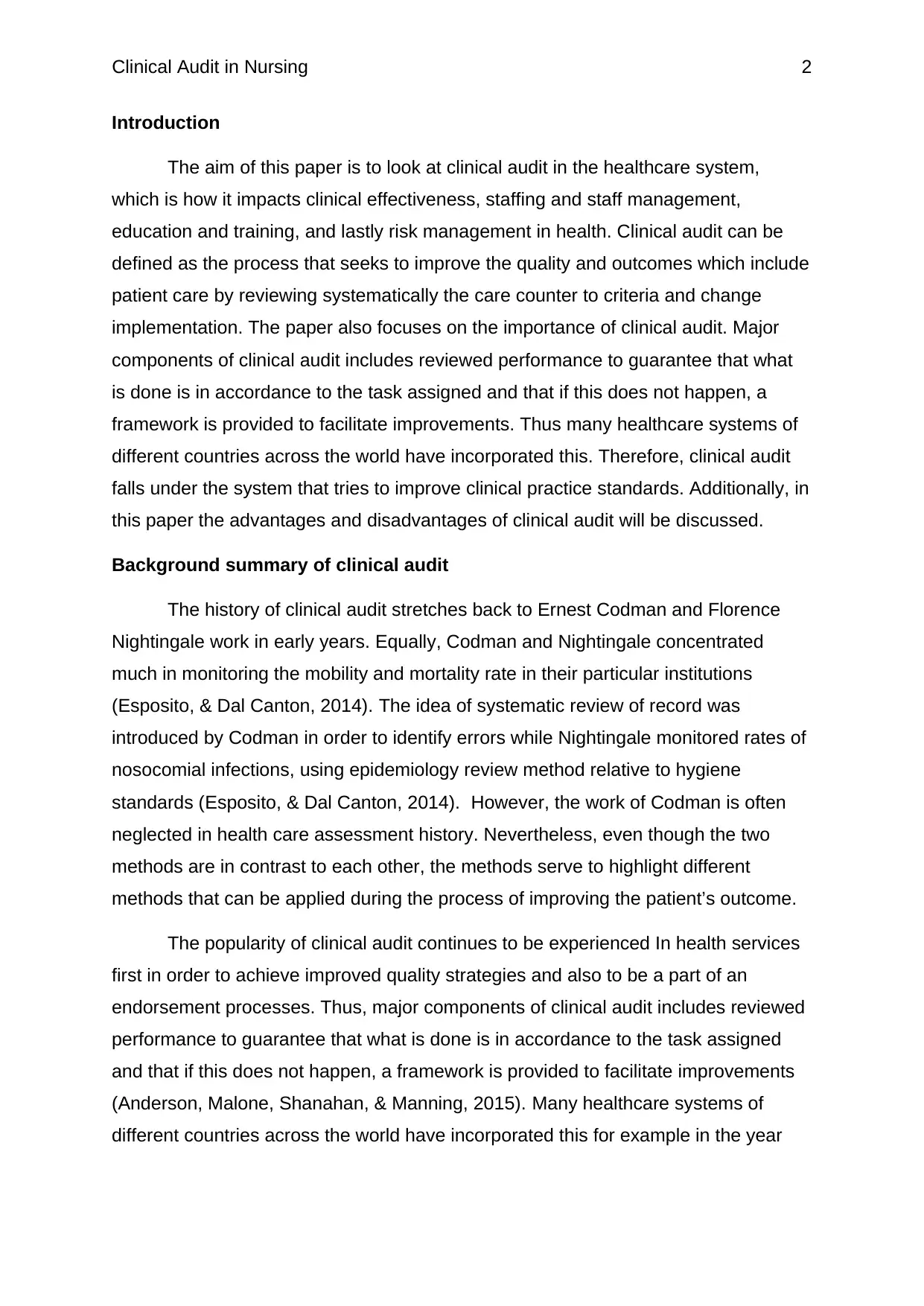
Clinical Audit in Nursing 2
Introduction
The aim of this paper is to look at clinical audit in the healthcare system,
which is how it impacts clinical effectiveness, staffing and staff management,
education and training, and lastly risk management in health. Clinical audit can be
defined as the process that seeks to improve the quality and outcomes which include
patient care by reviewing systematically the care counter to criteria and change
implementation. The paper also focuses on the importance of clinical audit. Major
components of clinical audit includes reviewed performance to guarantee that what
is done is in accordance to the task assigned and that if this does not happen, a
framework is provided to facilitate improvements. Thus many healthcare systems of
different countries across the world have incorporated this. Therefore, clinical audit
falls under the system that tries to improve clinical practice standards. Additionally, in
this paper the advantages and disadvantages of clinical audit will be discussed.
Background summary of clinical audit
The history of clinical audit stretches back to Ernest Codman and Florence
Nightingale work in early years. Equally, Codman and Nightingale concentrated
much in monitoring the mobility and mortality rate in their particular institutions
(Esposito, & Dal Canton, 2014). The idea of systematic review of record was
introduced by Codman in order to identify errors while Nightingale monitored rates of
nosocomial infections, using epidemiology review method relative to hygiene
standards (Esposito, & Dal Canton, 2014). However, the work of Codman is often
neglected in health care assessment history. Nevertheless, even though the two
methods are in contrast to each other, the methods serve to highlight different
methods that can be applied during the process of improving the patient’s outcome.
The popularity of clinical audit continues to be experienced In health services
first in order to achieve improved quality strategies and also to be a part of an
endorsement processes. Thus, major components of clinical audit includes reviewed
performance to guarantee that what is done is in accordance to the task assigned
and that if this does not happen, a framework is provided to facilitate improvements
(Anderson, Malone, Shanahan, & Manning, 2015). Many healthcare systems of
different countries across the world have incorporated this for example in the year
Introduction
The aim of this paper is to look at clinical audit in the healthcare system,
which is how it impacts clinical effectiveness, staffing and staff management,
education and training, and lastly risk management in health. Clinical audit can be
defined as the process that seeks to improve the quality and outcomes which include
patient care by reviewing systematically the care counter to criteria and change
implementation. The paper also focuses on the importance of clinical audit. Major
components of clinical audit includes reviewed performance to guarantee that what
is done is in accordance to the task assigned and that if this does not happen, a
framework is provided to facilitate improvements. Thus many healthcare systems of
different countries across the world have incorporated this. Therefore, clinical audit
falls under the system that tries to improve clinical practice standards. Additionally, in
this paper the advantages and disadvantages of clinical audit will be discussed.
Background summary of clinical audit
The history of clinical audit stretches back to Ernest Codman and Florence
Nightingale work in early years. Equally, Codman and Nightingale concentrated
much in monitoring the mobility and mortality rate in their particular institutions
(Esposito, & Dal Canton, 2014). The idea of systematic review of record was
introduced by Codman in order to identify errors while Nightingale monitored rates of
nosocomial infections, using epidemiology review method relative to hygiene
standards (Esposito, & Dal Canton, 2014). However, the work of Codman is often
neglected in health care assessment history. Nevertheless, even though the two
methods are in contrast to each other, the methods serve to highlight different
methods that can be applied during the process of improving the patient’s outcome.
The popularity of clinical audit continues to be experienced In health services
first in order to achieve improved quality strategies and also to be a part of an
endorsement processes. Thus, major components of clinical audit includes reviewed
performance to guarantee that what is done is in accordance to the task assigned
and that if this does not happen, a framework is provided to facilitate improvements
(Anderson, Malone, Shanahan, & Manning, 2015). Many healthcare systems of
different countries across the world have incorporated this for example in the year
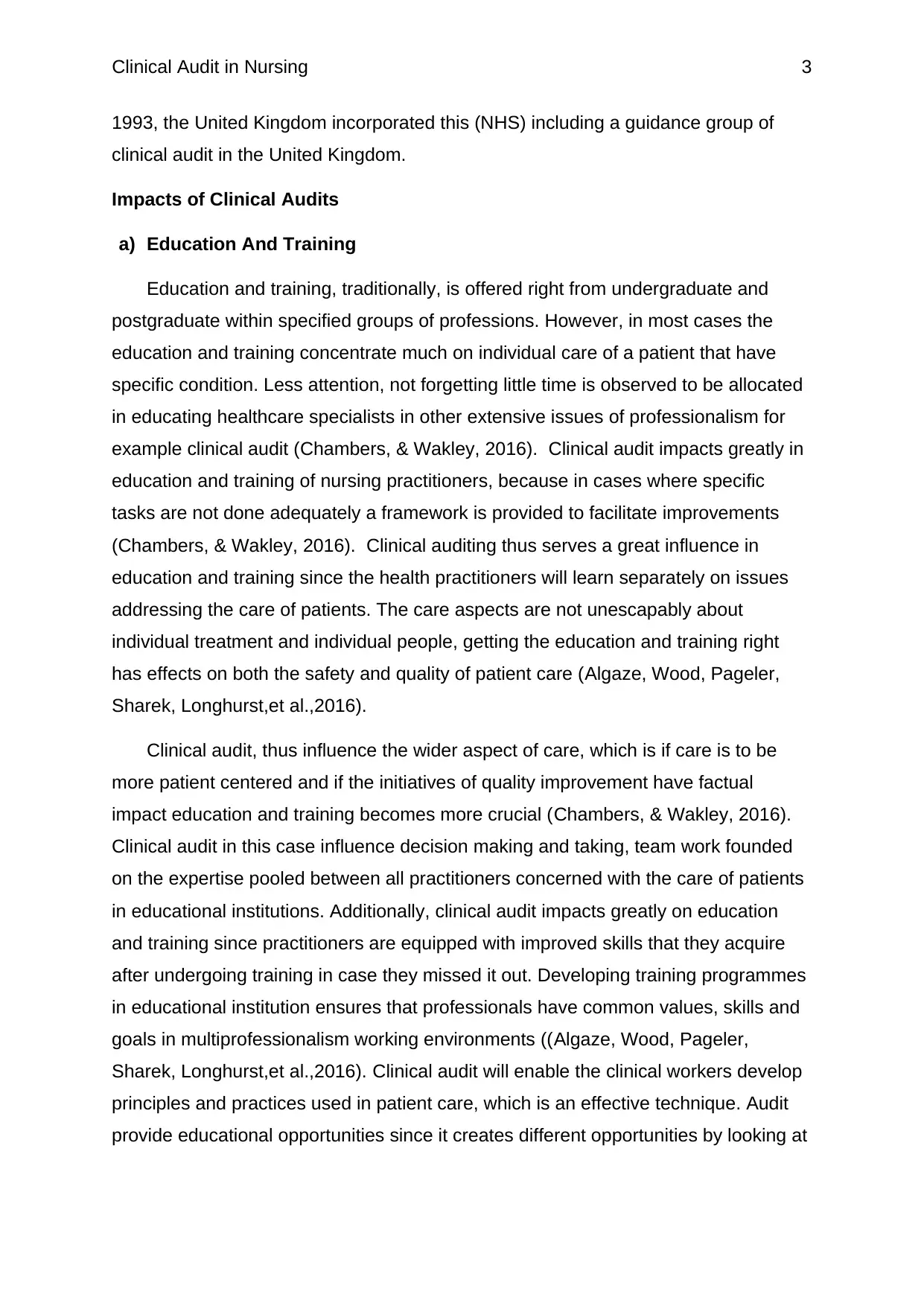
Clinical Audit in Nursing 3
1993, the United Kingdom incorporated this (NHS) including a guidance group of
clinical audit in the United Kingdom.
Impacts of Clinical Audits
a) Education And Training
Education and training, traditionally, is offered right from undergraduate and
postgraduate within specified groups of professions. However, in most cases the
education and training concentrate much on individual care of a patient that have
specific condition. Less attention, not forgetting little time is observed to be allocated
in educating healthcare specialists in other extensive issues of professionalism for
example clinical audit (Chambers, & Wakley, 2016). Clinical audit impacts greatly in
education and training of nursing practitioners, because in cases where specific
tasks are not done adequately a framework is provided to facilitate improvements
(Chambers, & Wakley, 2016). Clinical auditing thus serves a great influence in
education and training since the health practitioners will learn separately on issues
addressing the care of patients. The care aspects are not unescapably about
individual treatment and individual people, getting the education and training right
has effects on both the safety and quality of patient care (Algaze, Wood, Pageler,
Sharek, Longhurst,et al.,2016).
Clinical audit, thus influence the wider aspect of care, which is if care is to be
more patient centered and if the initiatives of quality improvement have factual
impact education and training becomes more crucial (Chambers, & Wakley, 2016).
Clinical audit in this case influence decision making and taking, team work founded
on the expertise pooled between all practitioners concerned with the care of patients
in educational institutions. Additionally, clinical audit impacts greatly on education
and training since practitioners are equipped with improved skills that they acquire
after undergoing training in case they missed it out. Developing training programmes
in educational institution ensures that professionals have common values, skills and
goals in multiprofessionalism working environments ((Algaze, Wood, Pageler,
Sharek, Longhurst,et al.,2016). Clinical audit will enable the clinical workers develop
principles and practices used in patient care, which is an effective technique. Audit
provide educational opportunities since it creates different opportunities by looking at
1993, the United Kingdom incorporated this (NHS) including a guidance group of
clinical audit in the United Kingdom.
Impacts of Clinical Audits
a) Education And Training
Education and training, traditionally, is offered right from undergraduate and
postgraduate within specified groups of professions. However, in most cases the
education and training concentrate much on individual care of a patient that have
specific condition. Less attention, not forgetting little time is observed to be allocated
in educating healthcare specialists in other extensive issues of professionalism for
example clinical audit (Chambers, & Wakley, 2016). Clinical audit impacts greatly in
education and training of nursing practitioners, because in cases where specific
tasks are not done adequately a framework is provided to facilitate improvements
(Chambers, & Wakley, 2016). Clinical auditing thus serves a great influence in
education and training since the health practitioners will learn separately on issues
addressing the care of patients. The care aspects are not unescapably about
individual treatment and individual people, getting the education and training right
has effects on both the safety and quality of patient care (Algaze, Wood, Pageler,
Sharek, Longhurst,et al.,2016).
Clinical audit, thus influence the wider aspect of care, which is if care is to be
more patient centered and if the initiatives of quality improvement have factual
impact education and training becomes more crucial (Chambers, & Wakley, 2016).
Clinical audit in this case influence decision making and taking, team work founded
on the expertise pooled between all practitioners concerned with the care of patients
in educational institutions. Additionally, clinical audit impacts greatly on education
and training since practitioners are equipped with improved skills that they acquire
after undergoing training in case they missed it out. Developing training programmes
in educational institution ensures that professionals have common values, skills and
goals in multiprofessionalism working environments ((Algaze, Wood, Pageler,
Sharek, Longhurst,et al.,2016). Clinical audit will enable the clinical workers develop
principles and practices used in patient care, which is an effective technique. Audit
provide educational opportunities since it creates different opportunities by looking at
⊘ This is a preview!⊘
Do you want full access?
Subscribe today to unlock all pages.

Trusted by 1+ million students worldwide
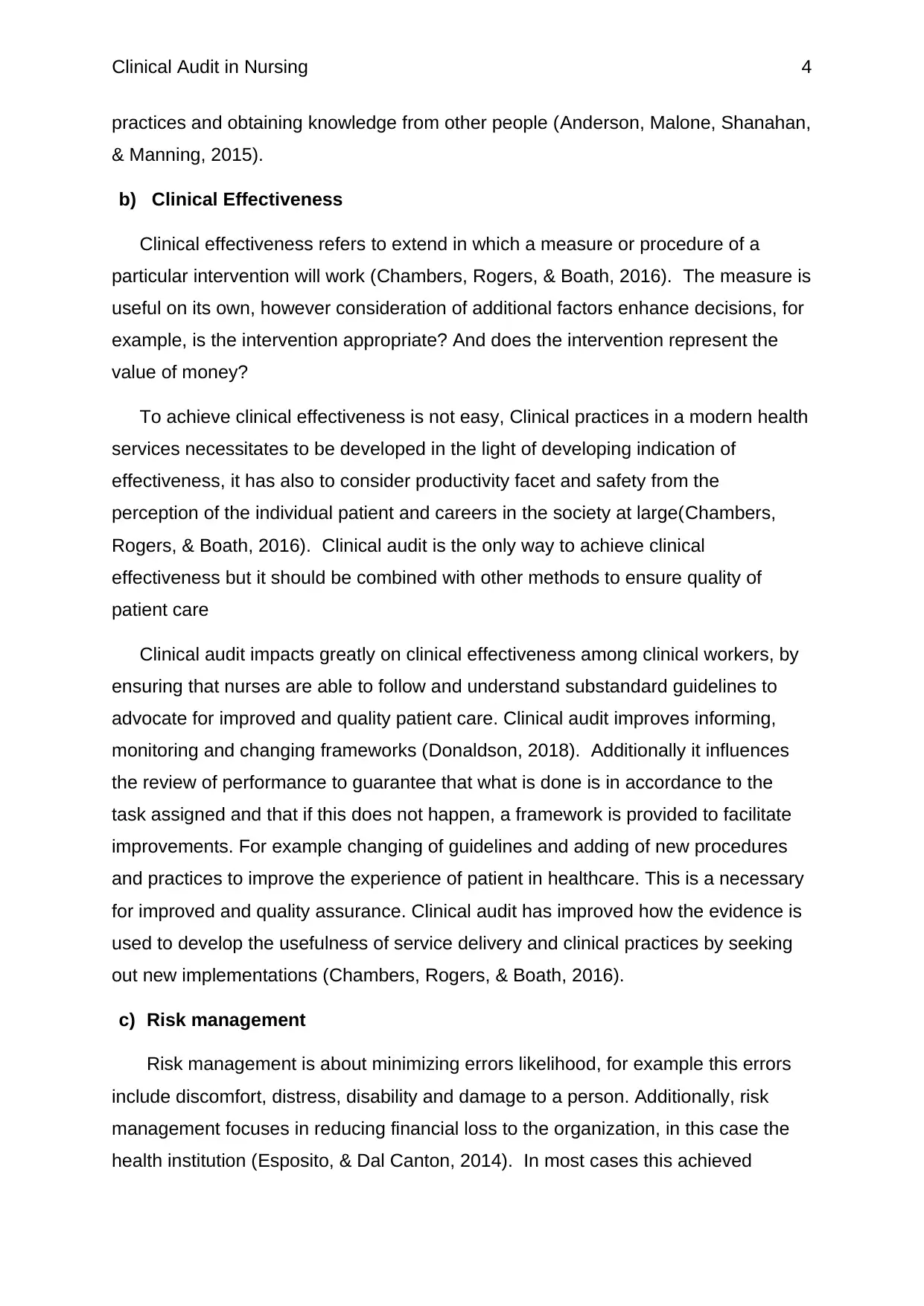
Clinical Audit in Nursing 4
practices and obtaining knowledge from other people (Anderson, Malone, Shanahan,
& Manning, 2015).
b) Clinical Effectiveness
Clinical effectiveness refers to extend in which a measure or procedure of a
particular intervention will work (Chambers, Rogers, & Boath, 2016). The measure is
useful on its own, however consideration of additional factors enhance decisions, for
example, is the intervention appropriate? And does the intervention represent the
value of money?
To achieve clinical effectiveness is not easy, Clinical practices in a modern health
services necessitates to be developed in the light of developing indication of
effectiveness, it has also to consider productivity facet and safety from the
perception of the individual patient and careers in the society at large(Chambers,
Rogers, & Boath, 2016). Clinical audit is the only way to achieve clinical
effectiveness but it should be combined with other methods to ensure quality of
patient care
Clinical audit impacts greatly on clinical effectiveness among clinical workers, by
ensuring that nurses are able to follow and understand substandard guidelines to
advocate for improved and quality patient care. Clinical audit improves informing,
monitoring and changing frameworks (Donaldson, 2018). Additionally it influences
the review of performance to guarantee that what is done is in accordance to the
task assigned and that if this does not happen, a framework is provided to facilitate
improvements. For example changing of guidelines and adding of new procedures
and practices to improve the experience of patient in healthcare. This is a necessary
for improved and quality assurance. Clinical audit has improved how the evidence is
used to develop the usefulness of service delivery and clinical practices by seeking
out new implementations (Chambers, Rogers, & Boath, 2016).
c) Risk management
Risk management is about minimizing errors likelihood, for example this errors
include discomfort, distress, disability and damage to a person. Additionally, risk
management focuses in reducing financial loss to the organization, in this case the
health institution (Esposito, & Dal Canton, 2014). In most cases this achieved
practices and obtaining knowledge from other people (Anderson, Malone, Shanahan,
& Manning, 2015).
b) Clinical Effectiveness
Clinical effectiveness refers to extend in which a measure or procedure of a
particular intervention will work (Chambers, Rogers, & Boath, 2016). The measure is
useful on its own, however consideration of additional factors enhance decisions, for
example, is the intervention appropriate? And does the intervention represent the
value of money?
To achieve clinical effectiveness is not easy, Clinical practices in a modern health
services necessitates to be developed in the light of developing indication of
effectiveness, it has also to consider productivity facet and safety from the
perception of the individual patient and careers in the society at large(Chambers,
Rogers, & Boath, 2016). Clinical audit is the only way to achieve clinical
effectiveness but it should be combined with other methods to ensure quality of
patient care
Clinical audit impacts greatly on clinical effectiveness among clinical workers, by
ensuring that nurses are able to follow and understand substandard guidelines to
advocate for improved and quality patient care. Clinical audit improves informing,
monitoring and changing frameworks (Donaldson, 2018). Additionally it influences
the review of performance to guarantee that what is done is in accordance to the
task assigned and that if this does not happen, a framework is provided to facilitate
improvements. For example changing of guidelines and adding of new procedures
and practices to improve the experience of patient in healthcare. This is a necessary
for improved and quality assurance. Clinical audit has improved how the evidence is
used to develop the usefulness of service delivery and clinical practices by seeking
out new implementations (Chambers, Rogers, & Boath, 2016).
c) Risk management
Risk management is about minimizing errors likelihood, for example this errors
include discomfort, distress, disability and damage to a person. Additionally, risk
management focuses in reducing financial loss to the organization, in this case the
health institution (Esposito, & Dal Canton, 2014). In most cases this achieved
Paraphrase This Document
Need a fresh take? Get an instant paraphrase of this document with our AI Paraphraser
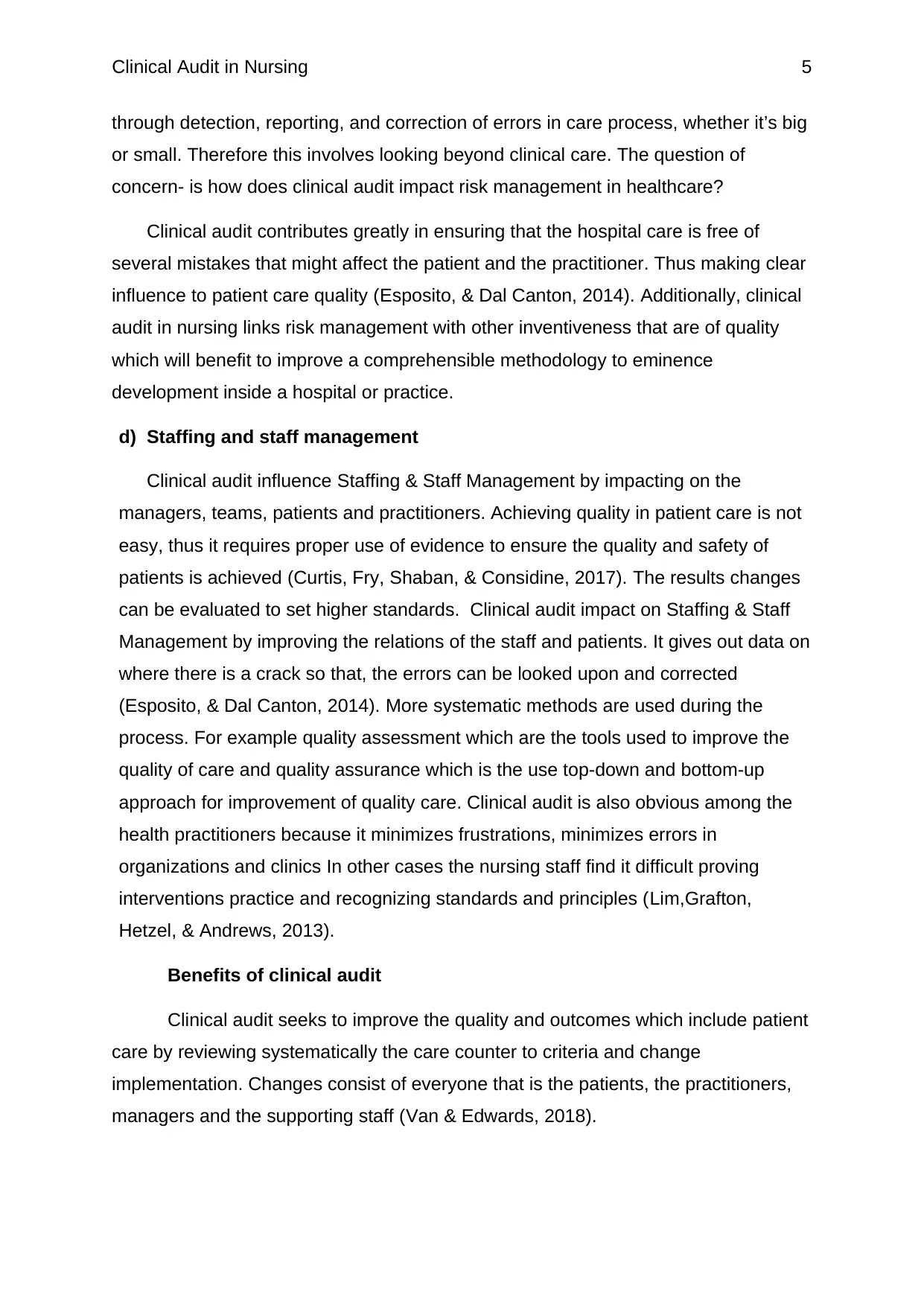
Clinical Audit in Nursing 5
through detection, reporting, and correction of errors in care process, whether it’s big
or small. Therefore this involves looking beyond clinical care. The question of
concern- is how does clinical audit impact risk management in healthcare?
Clinical audit contributes greatly in ensuring that the hospital care is free of
several mistakes that might affect the patient and the practitioner. Thus making clear
influence to patient care quality (Esposito, & Dal Canton, 2014). Additionally, clinical
audit in nursing links risk management with other inventiveness that are of quality
which will benefit to improve a comprehensible methodology to eminence
development inside a hospital or practice.
d) Staffing and staff management
Clinical audit influence Staffing & Staff Management by impacting on the
managers, teams, patients and practitioners. Achieving quality in patient care is not
easy, thus it requires proper use of evidence to ensure the quality and safety of
patients is achieved (Curtis, Fry, Shaban, & Considine, 2017). The results changes
can be evaluated to set higher standards. Clinical audit impact on Staffing & Staff
Management by improving the relations of the staff and patients. It gives out data on
where there is a crack so that, the errors can be looked upon and corrected
(Esposito, & Dal Canton, 2014). More systematic methods are used during the
process. For example quality assessment which are the tools used to improve the
quality of care and quality assurance which is the use top-down and bottom-up
approach for improvement of quality care. Clinical audit is also obvious among the
health practitioners because it minimizes frustrations, minimizes errors in
organizations and clinics In other cases the nursing staff find it difficult proving
interventions practice and recognizing standards and principles (Lim,Grafton,
Hetzel, & Andrews, 2013).
Benefits of clinical audit
Clinical audit seeks to improve the quality and outcomes which include patient
care by reviewing systematically the care counter to criteria and change
implementation. Changes consist of everyone that is the patients, the practitioners,
managers and the supporting staff (Van & Edwards, 2018).
through detection, reporting, and correction of errors in care process, whether it’s big
or small. Therefore this involves looking beyond clinical care. The question of
concern- is how does clinical audit impact risk management in healthcare?
Clinical audit contributes greatly in ensuring that the hospital care is free of
several mistakes that might affect the patient and the practitioner. Thus making clear
influence to patient care quality (Esposito, & Dal Canton, 2014). Additionally, clinical
audit in nursing links risk management with other inventiveness that are of quality
which will benefit to improve a comprehensible methodology to eminence
development inside a hospital or practice.
d) Staffing and staff management
Clinical audit influence Staffing & Staff Management by impacting on the
managers, teams, patients and practitioners. Achieving quality in patient care is not
easy, thus it requires proper use of evidence to ensure the quality and safety of
patients is achieved (Curtis, Fry, Shaban, & Considine, 2017). The results changes
can be evaluated to set higher standards. Clinical audit impact on Staffing & Staff
Management by improving the relations of the staff and patients. It gives out data on
where there is a crack so that, the errors can be looked upon and corrected
(Esposito, & Dal Canton, 2014). More systematic methods are used during the
process. For example quality assessment which are the tools used to improve the
quality of care and quality assurance which is the use top-down and bottom-up
approach for improvement of quality care. Clinical audit is also obvious among the
health practitioners because it minimizes frustrations, minimizes errors in
organizations and clinics In other cases the nursing staff find it difficult proving
interventions practice and recognizing standards and principles (Lim,Grafton,
Hetzel, & Andrews, 2013).
Benefits of clinical audit
Clinical audit seeks to improve the quality and outcomes which include patient
care by reviewing systematically the care counter to criteria and change
implementation. Changes consist of everyone that is the patients, the practitioners,
managers and the supporting staff (Van & Edwards, 2018).
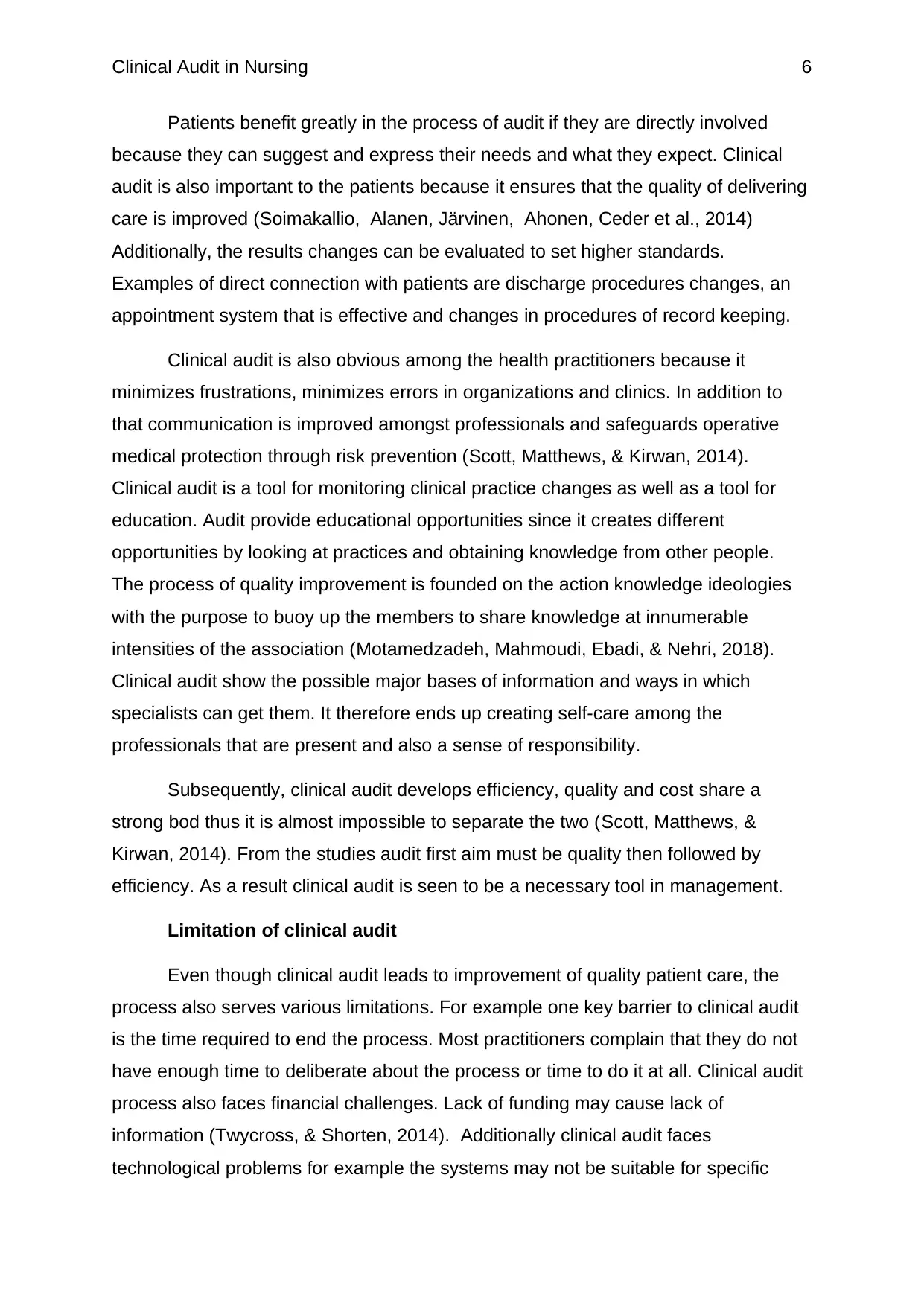
Clinical Audit in Nursing 6
Patients benefit greatly in the process of audit if they are directly involved
because they can suggest and express their needs and what they expect. Clinical
audit is also important to the patients because it ensures that the quality of delivering
care is improved (Soimakallio, Alanen, Järvinen, Ahonen, Ceder et al., 2014)
Additionally, the results changes can be evaluated to set higher standards.
Examples of direct connection with patients are discharge procedures changes, an
appointment system that is effective and changes in procedures of record keeping.
Clinical audit is also obvious among the health practitioners because it
minimizes frustrations, minimizes errors in organizations and clinics. In addition to
that communication is improved amongst professionals and safeguards operative
medical protection through risk prevention (Scott, Matthews, & Kirwan, 2014).
Clinical audit is a tool for monitoring clinical practice changes as well as a tool for
education. Audit provide educational opportunities since it creates different
opportunities by looking at practices and obtaining knowledge from other people.
The process of quality improvement is founded on the action knowledge ideologies
with the purpose to buoy up the members to share knowledge at innumerable
intensities of the association (Motamedzadeh, Mahmoudi, Ebadi, & Nehri, 2018).
Clinical audit show the possible major bases of information and ways in which
specialists can get them. It therefore ends up creating self-care among the
professionals that are present and also a sense of responsibility.
Subsequently, clinical audit develops efficiency, quality and cost share a
strong bod thus it is almost impossible to separate the two (Scott, Matthews, &
Kirwan, 2014). From the studies audit first aim must be quality then followed by
efficiency. As a result clinical audit is seen to be a necessary tool in management.
Limitation of clinical audit
Even though clinical audit leads to improvement of quality patient care, the
process also serves various limitations. For example one key barrier to clinical audit
is the time required to end the process. Most practitioners complain that they do not
have enough time to deliberate about the process or time to do it at all. Clinical audit
process also faces financial challenges. Lack of funding may cause lack of
information (Twycross, & Shorten, 2014). Additionally clinical audit faces
technological problems for example the systems may not be suitable for specific
Patients benefit greatly in the process of audit if they are directly involved
because they can suggest and express their needs and what they expect. Clinical
audit is also important to the patients because it ensures that the quality of delivering
care is improved (Soimakallio, Alanen, Järvinen, Ahonen, Ceder et al., 2014)
Additionally, the results changes can be evaluated to set higher standards.
Examples of direct connection with patients are discharge procedures changes, an
appointment system that is effective and changes in procedures of record keeping.
Clinical audit is also obvious among the health practitioners because it
minimizes frustrations, minimizes errors in organizations and clinics. In addition to
that communication is improved amongst professionals and safeguards operative
medical protection through risk prevention (Scott, Matthews, & Kirwan, 2014).
Clinical audit is a tool for monitoring clinical practice changes as well as a tool for
education. Audit provide educational opportunities since it creates different
opportunities by looking at practices and obtaining knowledge from other people.
The process of quality improvement is founded on the action knowledge ideologies
with the purpose to buoy up the members to share knowledge at innumerable
intensities of the association (Motamedzadeh, Mahmoudi, Ebadi, & Nehri, 2018).
Clinical audit show the possible major bases of information and ways in which
specialists can get them. It therefore ends up creating self-care among the
professionals that are present and also a sense of responsibility.
Subsequently, clinical audit develops efficiency, quality and cost share a
strong bod thus it is almost impossible to separate the two (Scott, Matthews, &
Kirwan, 2014). From the studies audit first aim must be quality then followed by
efficiency. As a result clinical audit is seen to be a necessary tool in management.
Limitation of clinical audit
Even though clinical audit leads to improvement of quality patient care, the
process also serves various limitations. For example one key barrier to clinical audit
is the time required to end the process. Most practitioners complain that they do not
have enough time to deliberate about the process or time to do it at all. Clinical audit
process also faces financial challenges. Lack of funding may cause lack of
information (Twycross, & Shorten, 2014). Additionally clinical audit faces
technological problems for example the systems may not be suitable for specific
⊘ This is a preview!⊘
Do you want full access?
Subscribe today to unlock all pages.

Trusted by 1+ million students worldwide
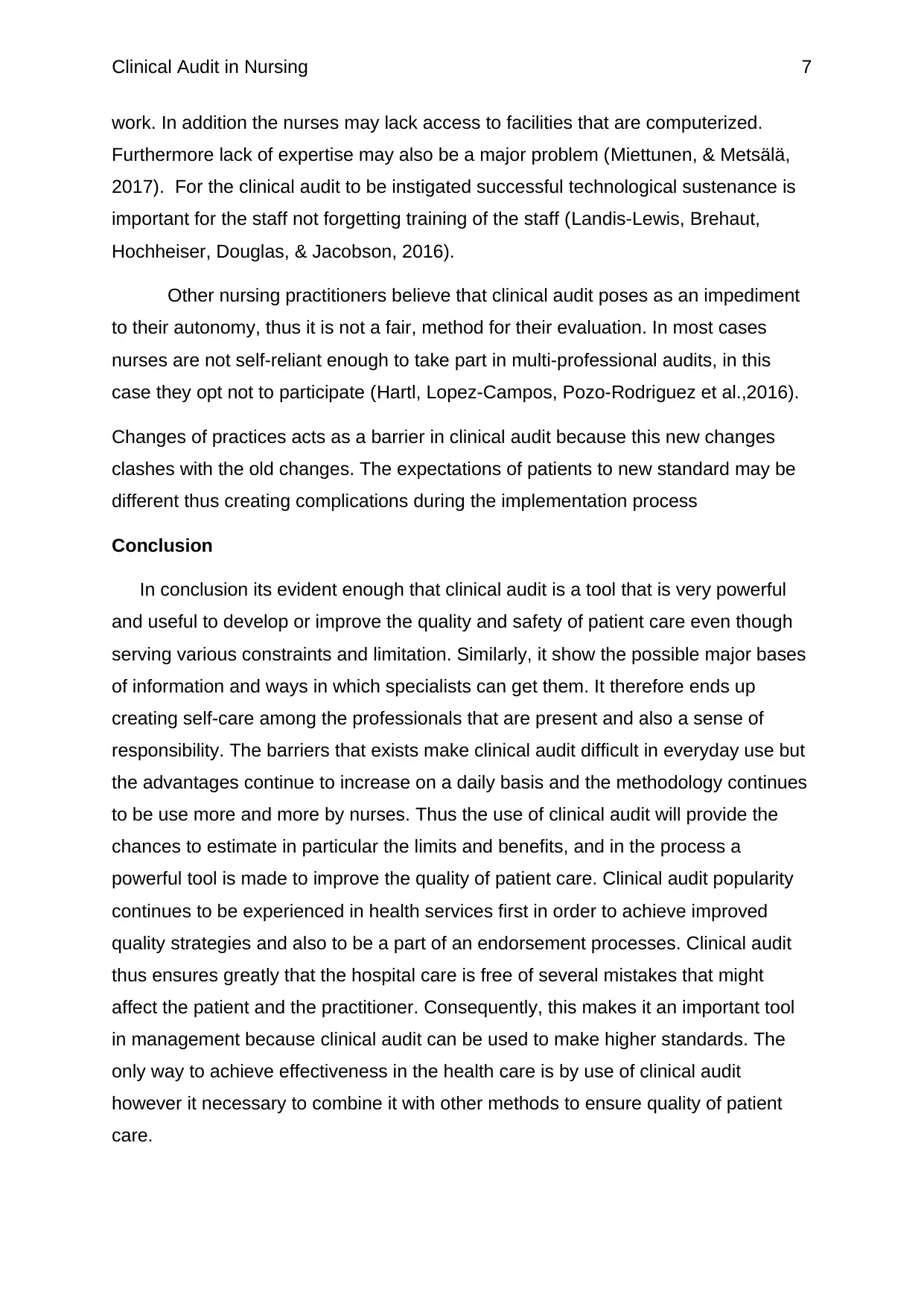
Clinical Audit in Nursing 7
work. In addition the nurses may lack access to facilities that are computerized.
Furthermore lack of expertise may also be a major problem (Miettunen, & Metsälä,
2017). For the clinical audit to be instigated successful technological sustenance is
important for the staff not forgetting training of the staff (Landis-Lewis, Brehaut,
Hochheiser, Douglas, & Jacobson, 2016).
Other nursing practitioners believe that clinical audit poses as an impediment
to their autonomy, thus it is not a fair, method for their evaluation. In most cases
nurses are not self-reliant enough to take part in multi-professional audits, in this
case they opt not to participate (Hartl, Lopez-Campos, Pozo-Rodriguez et al.,2016).
Changes of practices acts as a barrier in clinical audit because this new changes
clashes with the old changes. The expectations of patients to new standard may be
different thus creating complications during the implementation process
Conclusion
In conclusion its evident enough that clinical audit is a tool that is very powerful
and useful to develop or improve the quality and safety of patient care even though
serving various constraints and limitation. Similarly, it show the possible major bases
of information and ways in which specialists can get them. It therefore ends up
creating self-care among the professionals that are present and also a sense of
responsibility. The barriers that exists make clinical audit difficult in everyday use but
the advantages continue to increase on a daily basis and the methodology continues
to be use more and more by nurses. Thus the use of clinical audit will provide the
chances to estimate in particular the limits and benefits, and in the process a
powerful tool is made to improve the quality of patient care. Clinical audit popularity
continues to be experienced in health services first in order to achieve improved
quality strategies and also to be a part of an endorsement processes. Clinical audit
thus ensures greatly that the hospital care is free of several mistakes that might
affect the patient and the practitioner. Consequently, this makes it an important tool
in management because clinical audit can be used to make higher standards. The
only way to achieve effectiveness in the health care is by use of clinical audit
however it necessary to combine it with other methods to ensure quality of patient
care.
work. In addition the nurses may lack access to facilities that are computerized.
Furthermore lack of expertise may also be a major problem (Miettunen, & Metsälä,
2017). For the clinical audit to be instigated successful technological sustenance is
important for the staff not forgetting training of the staff (Landis-Lewis, Brehaut,
Hochheiser, Douglas, & Jacobson, 2016).
Other nursing practitioners believe that clinical audit poses as an impediment
to their autonomy, thus it is not a fair, method for their evaluation. In most cases
nurses are not self-reliant enough to take part in multi-professional audits, in this
case they opt not to participate (Hartl, Lopez-Campos, Pozo-Rodriguez et al.,2016).
Changes of practices acts as a barrier in clinical audit because this new changes
clashes with the old changes. The expectations of patients to new standard may be
different thus creating complications during the implementation process
Conclusion
In conclusion its evident enough that clinical audit is a tool that is very powerful
and useful to develop or improve the quality and safety of patient care even though
serving various constraints and limitation. Similarly, it show the possible major bases
of information and ways in which specialists can get them. It therefore ends up
creating self-care among the professionals that are present and also a sense of
responsibility. The barriers that exists make clinical audit difficult in everyday use but
the advantages continue to increase on a daily basis and the methodology continues
to be use more and more by nurses. Thus the use of clinical audit will provide the
chances to estimate in particular the limits and benefits, and in the process a
powerful tool is made to improve the quality of patient care. Clinical audit popularity
continues to be experienced in health services first in order to achieve improved
quality strategies and also to be a part of an endorsement processes. Clinical audit
thus ensures greatly that the hospital care is free of several mistakes that might
affect the patient and the practitioner. Consequently, this makes it an important tool
in management because clinical audit can be used to make higher standards. The
only way to achieve effectiveness in the health care is by use of clinical audit
however it necessary to combine it with other methods to ensure quality of patient
care.
Paraphrase This Document
Need a fresh take? Get an instant paraphrase of this document with our AI Paraphraser
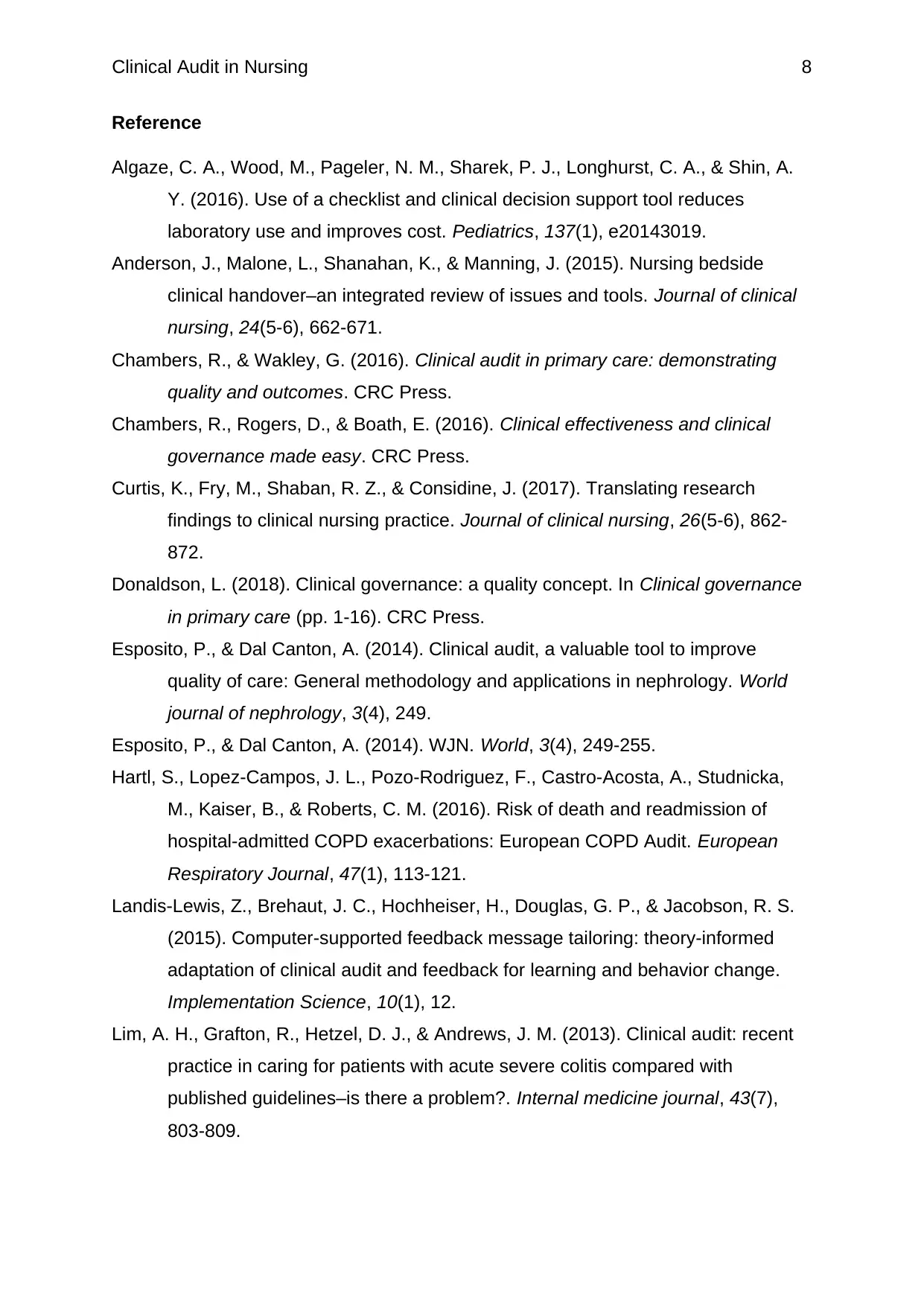
Clinical Audit in Nursing 8
Reference
Algaze, C. A., Wood, M., Pageler, N. M., Sharek, P. J., Longhurst, C. A., & Shin, A.
Y. (2016). Use of a checklist and clinical decision support tool reduces
laboratory use and improves cost. Pediatrics, 137(1), e20143019.
Anderson, J., Malone, L., Shanahan, K., & Manning, J. (2015). Nursing bedside
clinical handover–an integrated review of issues and tools. Journal of clinical
nursing, 24(5-6), 662-671.
Chambers, R., & Wakley, G. (2016). Clinical audit in primary care: demonstrating
quality and outcomes. CRC Press.
Chambers, R., Rogers, D., & Boath, E. (2016). Clinical effectiveness and clinical
governance made easy. CRC Press.
Curtis, K., Fry, M., Shaban, R. Z., & Considine, J. (2017). Translating research
findings to clinical nursing practice. Journal of clinical nursing, 26(5-6), 862-
872.
Donaldson, L. (2018). Clinical governance: a quality concept. In Clinical governance
in primary care (pp. 1-16). CRC Press.
Esposito, P., & Dal Canton, A. (2014). Clinical audit, a valuable tool to improve
quality of care: General methodology and applications in nephrology. World
journal of nephrology, 3(4), 249.
Esposito, P., & Dal Canton, A. (2014). WJN. World, 3(4), 249-255.
Hartl, S., Lopez-Campos, J. L., Pozo-Rodriguez, F., Castro-Acosta, A., Studnicka,
M., Kaiser, B., & Roberts, C. M. (2016). Risk of death and readmission of
hospital-admitted COPD exacerbations: European COPD Audit. European
Respiratory Journal, 47(1), 113-121.
Landis-Lewis, Z., Brehaut, J. C., Hochheiser, H., Douglas, G. P., & Jacobson, R. S.
(2015). Computer-supported feedback message tailoring: theory-informed
adaptation of clinical audit and feedback for learning and behavior change.
Implementation Science, 10(1), 12.
Lim, A. H., Grafton, R., Hetzel, D. J., & Andrews, J. M. (2013). Clinical audit: recent
practice in caring for patients with acute severe colitis compared with
published guidelines–is there a problem?. Internal medicine journal, 43(7),
803-809.
Reference
Algaze, C. A., Wood, M., Pageler, N. M., Sharek, P. J., Longhurst, C. A., & Shin, A.
Y. (2016). Use of a checklist and clinical decision support tool reduces
laboratory use and improves cost. Pediatrics, 137(1), e20143019.
Anderson, J., Malone, L., Shanahan, K., & Manning, J. (2015). Nursing bedside
clinical handover–an integrated review of issues and tools. Journal of clinical
nursing, 24(5-6), 662-671.
Chambers, R., & Wakley, G. (2016). Clinical audit in primary care: demonstrating
quality and outcomes. CRC Press.
Chambers, R., Rogers, D., & Boath, E. (2016). Clinical effectiveness and clinical
governance made easy. CRC Press.
Curtis, K., Fry, M., Shaban, R. Z., & Considine, J. (2017). Translating research
findings to clinical nursing practice. Journal of clinical nursing, 26(5-6), 862-
872.
Donaldson, L. (2018). Clinical governance: a quality concept. In Clinical governance
in primary care (pp. 1-16). CRC Press.
Esposito, P., & Dal Canton, A. (2014). Clinical audit, a valuable tool to improve
quality of care: General methodology and applications in nephrology. World
journal of nephrology, 3(4), 249.
Esposito, P., & Dal Canton, A. (2014). WJN. World, 3(4), 249-255.
Hartl, S., Lopez-Campos, J. L., Pozo-Rodriguez, F., Castro-Acosta, A., Studnicka,
M., Kaiser, B., & Roberts, C. M. (2016). Risk of death and readmission of
hospital-admitted COPD exacerbations: European COPD Audit. European
Respiratory Journal, 47(1), 113-121.
Landis-Lewis, Z., Brehaut, J. C., Hochheiser, H., Douglas, G. P., & Jacobson, R. S.
(2015). Computer-supported feedback message tailoring: theory-informed
adaptation of clinical audit and feedback for learning and behavior change.
Implementation Science, 10(1), 12.
Lim, A. H., Grafton, R., Hetzel, D. J., & Andrews, J. M. (2013). Clinical audit: recent
practice in caring for patients with acute severe colitis compared with
published guidelines–is there a problem?. Internal medicine journal, 43(7),
803-809.
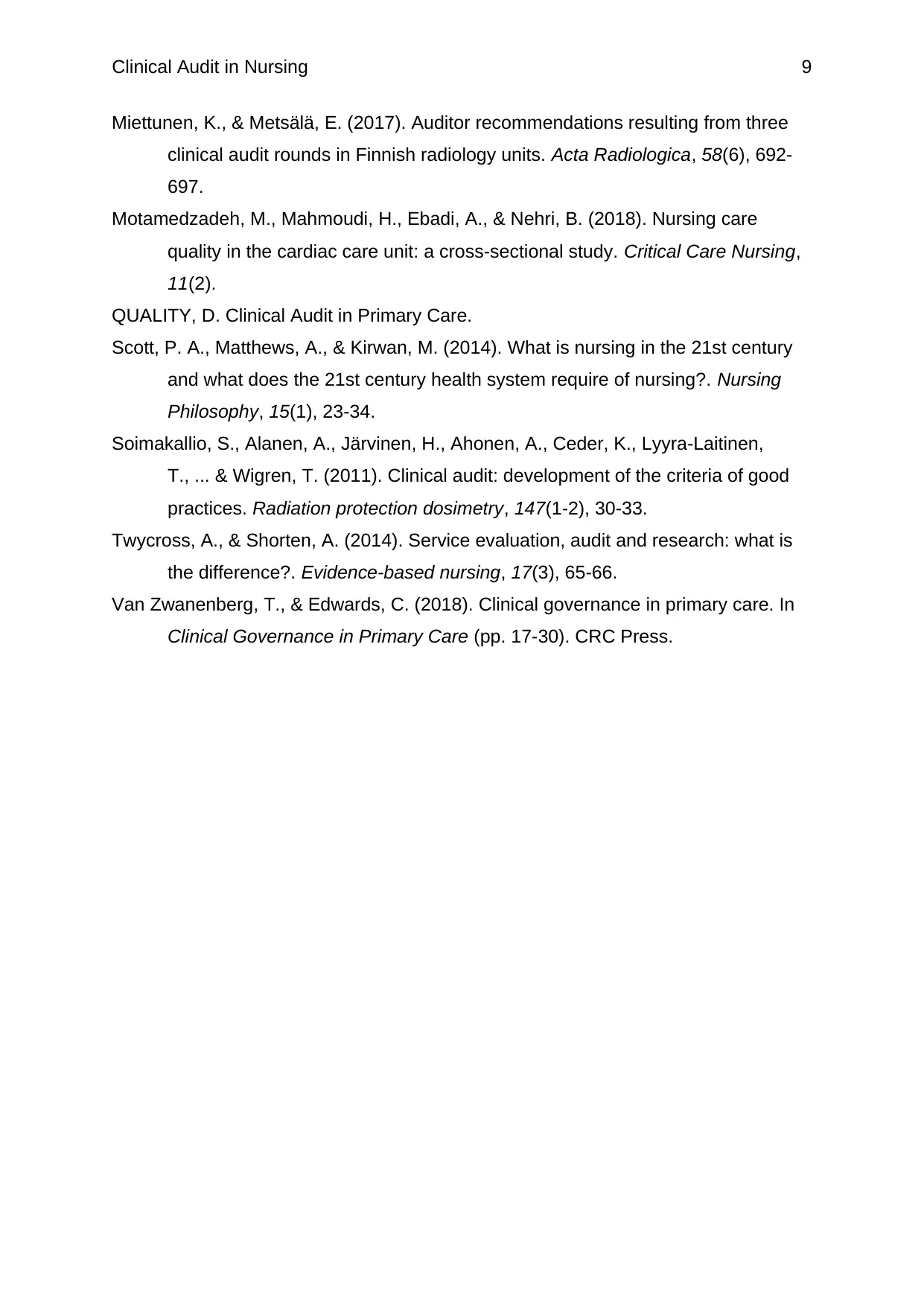
Clinical Audit in Nursing 9
Miettunen, K., & Metsälä, E. (2017). Auditor recommendations resulting from three
clinical audit rounds in Finnish radiology units. Acta Radiologica, 58(6), 692-
697.
Motamedzadeh, M., Mahmoudi, H., Ebadi, A., & Nehri, B. (2018). Nursing care
quality in the cardiac care unit: a cross-sectional study. Critical Care Nursing,
11(2).
QUALITY, D. Clinical Audit in Primary Care.
Scott, P. A., Matthews, A., & Kirwan, M. (2014). What is nursing in the 21st century
and what does the 21st century health system require of nursing?. Nursing
Philosophy, 15(1), 23-34.
Soimakallio, S., Alanen, A., Järvinen, H., Ahonen, A., Ceder, K., Lyyra-Laitinen,
T., ... & Wigren, T. (2011). Clinical audit: development of the criteria of good
practices. Radiation protection dosimetry, 147(1-2), 30-33.
Twycross, A., & Shorten, A. (2014). Service evaluation, audit and research: what is
the difference?. Evidence-based nursing, 17(3), 65-66.
Van Zwanenberg, T., & Edwards, C. (2018). Clinical governance in primary care. In
Clinical Governance in Primary Care (pp. 17-30). CRC Press.
Miettunen, K., & Metsälä, E. (2017). Auditor recommendations resulting from three
clinical audit rounds in Finnish radiology units. Acta Radiologica, 58(6), 692-
697.
Motamedzadeh, M., Mahmoudi, H., Ebadi, A., & Nehri, B. (2018). Nursing care
quality in the cardiac care unit: a cross-sectional study. Critical Care Nursing,
11(2).
QUALITY, D. Clinical Audit in Primary Care.
Scott, P. A., Matthews, A., & Kirwan, M. (2014). What is nursing in the 21st century
and what does the 21st century health system require of nursing?. Nursing
Philosophy, 15(1), 23-34.
Soimakallio, S., Alanen, A., Järvinen, H., Ahonen, A., Ceder, K., Lyyra-Laitinen,
T., ... & Wigren, T. (2011). Clinical audit: development of the criteria of good
practices. Radiation protection dosimetry, 147(1-2), 30-33.
Twycross, A., & Shorten, A. (2014). Service evaluation, audit and research: what is
the difference?. Evidence-based nursing, 17(3), 65-66.
Van Zwanenberg, T., & Edwards, C. (2018). Clinical governance in primary care. In
Clinical Governance in Primary Care (pp. 17-30). CRC Press.
⊘ This is a preview!⊘
Do you want full access?
Subscribe today to unlock all pages.

Trusted by 1+ million students worldwide
1 out of 9
Related Documents
Your All-in-One AI-Powered Toolkit for Academic Success.
+13062052269
info@desklib.com
Available 24*7 on WhatsApp / Email
![[object Object]](/_next/static/media/star-bottom.7253800d.svg)
Unlock your academic potential
Copyright © 2020–2025 A2Z Services. All Rights Reserved. Developed and managed by ZUCOL.





